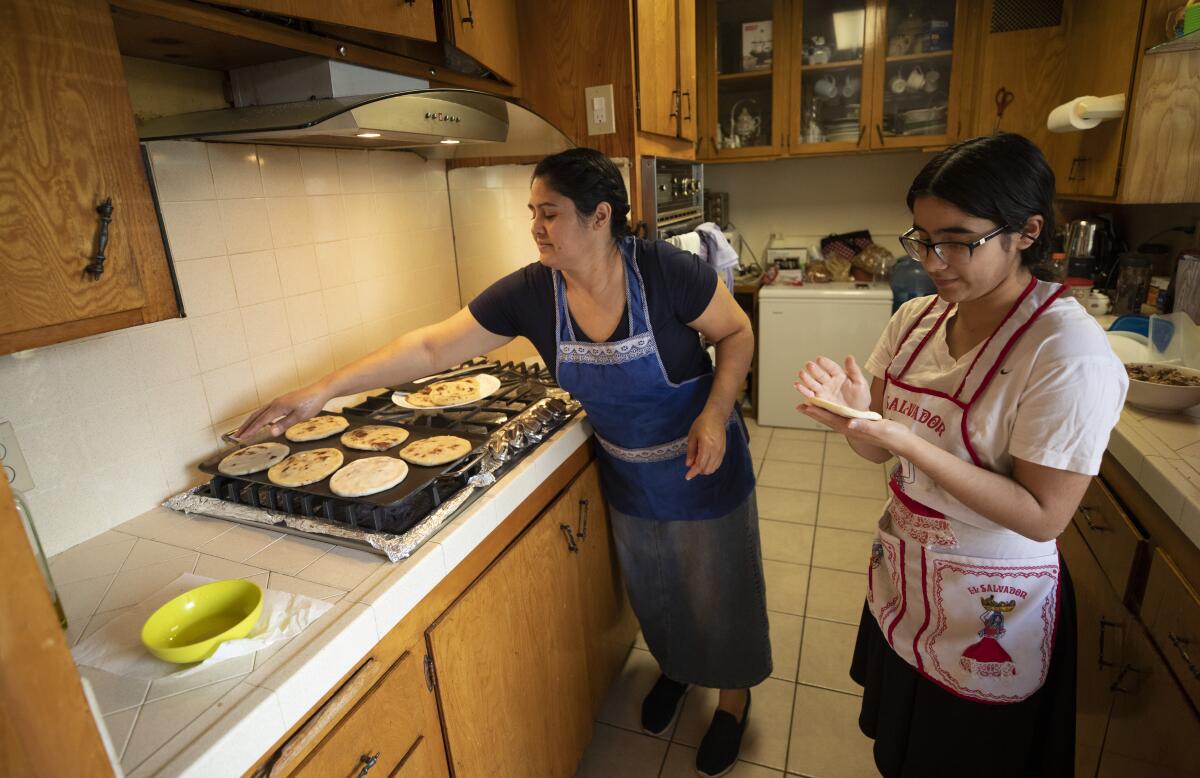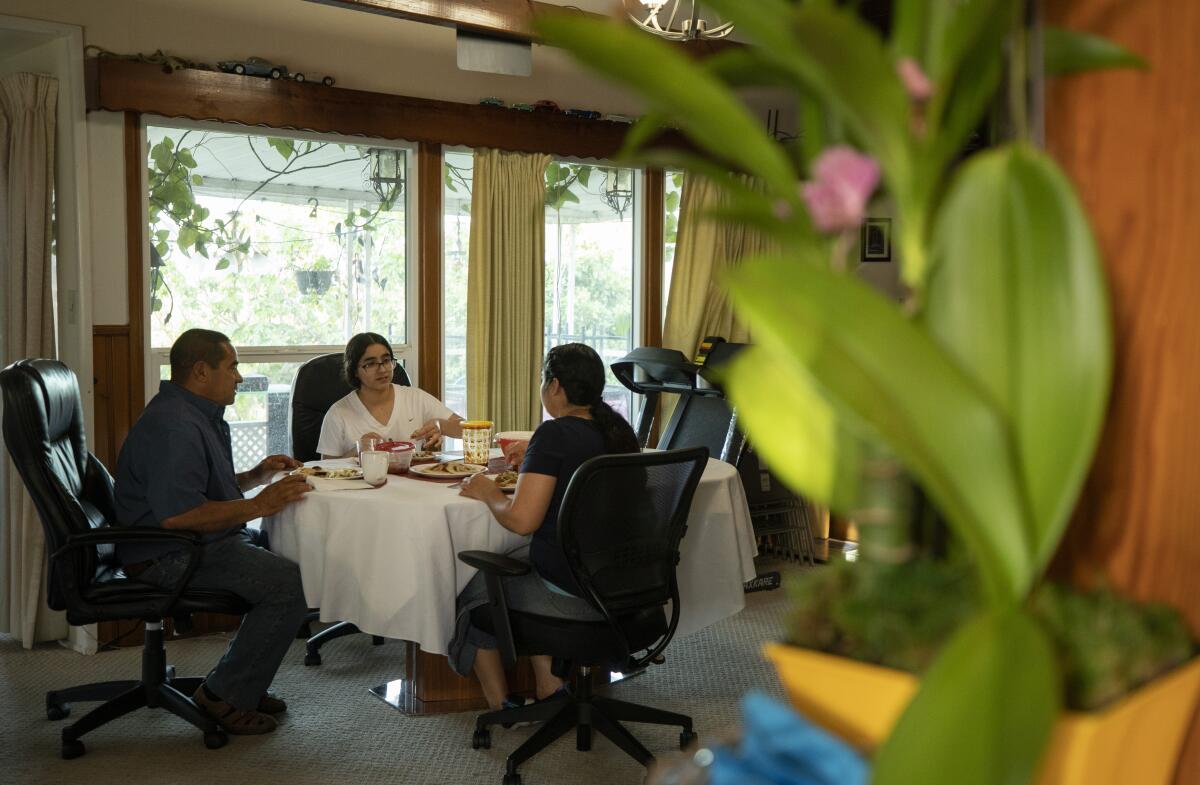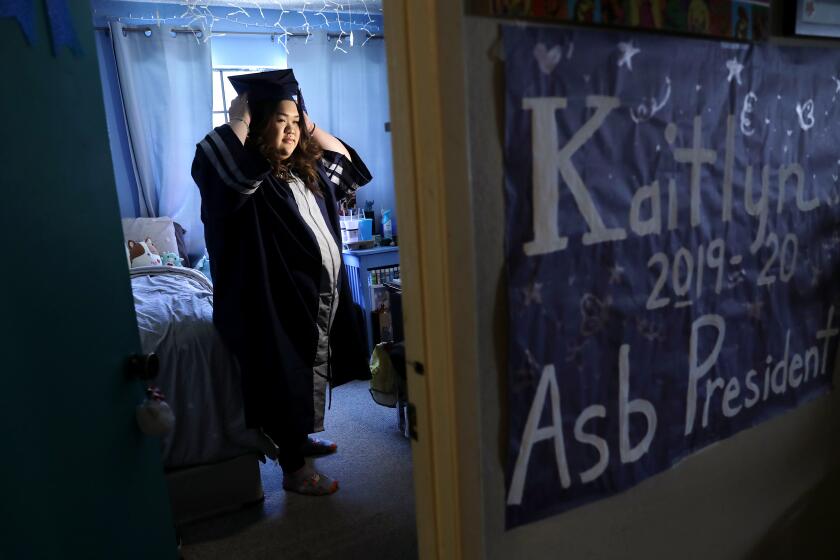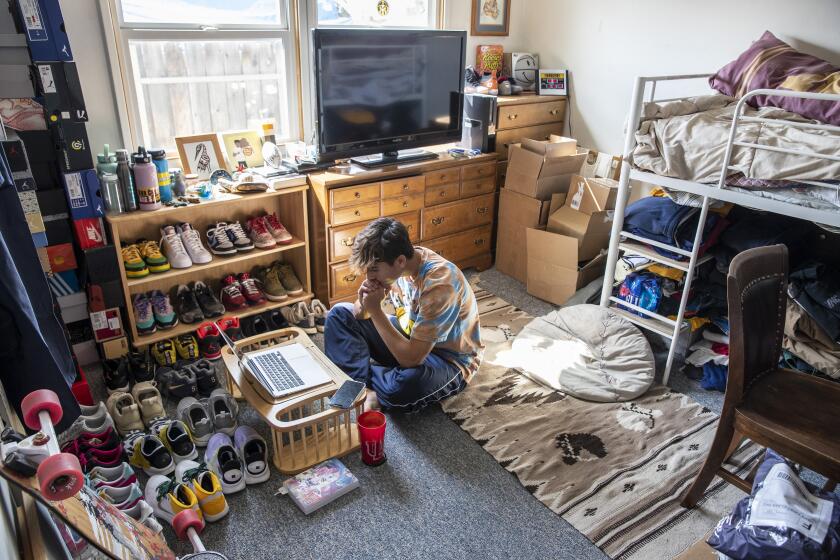UC explains admissions decisions in a record application year of much heartbreak, some joy

- Share via
The Burbank mother knew her high school senior would have a tough time competing for a freshman seat at a University of California campus in a year of record-shattering applications — more than 200,000 students were vying for about 46,000 spots. Still, she thought her daughter — with a 4.3 GPA, eight AP and honors courses and a host of extracurricular activities — would have a shot.
She was floored in March when the campus notifications began rolling in. Out of seven UC campuses, her daughter was denied or wait-listed at all but UC Merced.
“It was heartbreaking,” said the parent, who asked for anonymity to protect her daughter’s privacy at a time of great disappointment. “And I got really angry. We just got the rug pulled out from under us. What more could our kids possibly have done?”
That’s the question thousands of families and high school seniors are asking themselves in a college admissions season like no other — one marked by pandemic isolation, remote learning, disrupted activities and the elimination of standardized testing requirements at most universities across the country.
Surging college applications have been hailed as a sign that the dropping of testing requirements has lowered entry barriers for many students. But the flip side of more applications is more rejections and heartbreak — as well as widespread confusion over what it takes to get that coveted acceptance letter.
“I hate that im crying on camera but i just got rejected from 3 of my top UC’s,” @nicolesmangos said on a TikTok video. “Nothing just make sense to me right now.”
Although UC campuses will not release their admissions data until the summer, several private universities are reporting some of their lowest acceptance rates ever. USC dropped to 12% from 16% last year, admitting only 8,800 students among a record-high 71,000 applicants for fall 2021. In the Ivy League, Harvard declined to 3.4%, Columbia to 3.7% and Yale to 4.6%.
But many California parents expected that, unlike private universities, UC campuses supported by their taxes would have more room for their children who had toiled to earn top grades, challenge themselves in multiple college-level courses and engage in sports, student clubs and community service.
Claudia Boles, a Los Angeles clinical social worker, was disappointed that her son, Philip, was wait-listed at UC Santa Cruz, his top choice.
The campus seemed a perfect fit, offering the natural beauty and strong science courses that feed his passions. He seemed well qualified, meeting the mean 3.9 GPA for admitted Santa Cruz freshmen. His hobby of creating complex biospheres of plants and ponds for crustaceans, reptiles, fish and microorganisms, Boles thought, demonstrated her son’s talents.
Statewide enrollment is down.
He was accepted to two other UC campuses, but his heart is set on Santa Cruz, and he’s appealing for reconsideration. Like many students, he applied to multiple UC campuses.
“It’s frustrating because we know he’s qualified, and we know it’s the best fit for his interests and personality,” Boles said of Santa Cruz. “But he has two other options we’re all grateful for. We know it’s what you make of your experiences.”
UC admissions officers say the unusual year has presented myriad challenges. But some decision-making insights emerged.
Majors matter, they say. At UC Irvine, admissions officers had to review a record 108,000 applications for freshmen spots. Almost half of the students applied to just six of 85 majors — with biological sciences the top choice, selected by nearly 12,000 applicants. Other popular majors were business administration, nursing science, computer science and psychology.
Dale Leaman, UC Irvine’s executive director of undergraduate admissions, said Irvine probably couldn’t accommodate more than 10% of biological sciences applicants. Less popular majors would probably have a higher admission rate, he said. He added, however, that students shouldn’t try to game the system by applying to less selective majors, because they might not be able to change them under the strict rules for doing so.
Chloe Wilson, a San Marino High senior, said none of her friends were accepted to UC Irvine. She was, which excited but surprised her. Although her 4.2 GPA and eight Advanced Placement and honors classes were impressive, she said she felt “kind of underqualified” compared with friends who were wait-listed or denied despite stronger high school records.
But Chloe’s friends intend to major in science and psychology while she applied as undeclared and expects to major in a humanities field.
High school students recall their year at home as they prepare to return to campus for the first time since the pandemic began.
Without standardized test scores to guide selections for competitive majors requiring strong calculus and statistics skills, Leaman said, reviewers took a close look at whether students took a progression of increasingly more challenging math classes, including college-level AP courses.
At UC Santa Barbara, which received a record 105,640 applications, faculty told admissions officers they wanted active, engaged learners who involved themselves in their school and community. Even during the pandemic, did they seek out opportunities to learn through TED Talks? Did they volunteer for online tutoring or help family members stricken with COVID-19?
Lisa Przekop, UC Santa Barbara’s director of admissions, said her team also looked for evidence of sustained passion. If they expressed a love of science, did they take four years of the subject rather than the required two? Did they join any related clubs or summer programs? Reviewers counted intention to do so, she said, noting that the pandemic caused the cancellation of many such activities.
High school students The Times spoke to have struggled with online learning, and they miss their friends. But they’ve worked to cope and seek out hope.
“Basically, we’re looking for patterns that supported their interests,” Przekop said.
She added that Santa Barbara increased its wait-list offers to 14,000 from 10,000 last year as a hedge against pandemic uncertainty. But she said it was still too early to know how many wait-listed students would receive an admission offer, which varies. It climbed to an unusually high 1,400 for fall 2020 — compared with 253 the previous year — as more students declined to enroll for remote learning.
Santa Cruz also increased its wait-list offers while others, such as Irvine, kept about the same numbers.
UC admissions directors stressed that they evaluated students in the context of their own schools and communities to assess how much they challenged themselves and took advantage of available opportunities. A student who took all six AP classes offered at her school might be more impressive than the one who took six at a school that offered twice as many.
A campus might admit a student with a 4.0 GPA who ranked at the top of an underserved school over one with a higher GPA but lower class rank at a more high-achieving school.
“The thing I take the most pride in with the UC is that it’s all about achievement within context,” said Michelle Whittingham, UC Santa Cruz associate vice chancellor of enrollment management. “We get these calls: ‘My kid got this GPA.’ But at that particular school, it could be average or below average.”
UC application readers also look for persistence, resilience and grit — low-income students who had to work multiple jobs, for instance, to support their families and still excelled in a rigorous curriculum.
As UC touts equity and diversity, some families wonder whether certain demographic profiles are getting preference. But UC admissions officers say that reviewers are blocked from seeing the name, race, ethnicity and gender of applicants to avoid bias. The state Constitution bars affirmative action in public education based on race, ethnicity and gender but socioeconomic status may be considered.
“When a student is denied, it’s only natural for them to look for that one specific reason for the denial, but that’s not how the admission review process works,” Przekop said. “We do a holistic review, and every bit of information they share in their application is taken into account. Given the large volume of applications we receive, the realistic explanation is that there were just more applicants who were rated higher. More than half of our freshman applicant pool has a GPA of 4.0 or higher.”

Amanda Alarcon, a 17-year-old Los Angeles High senior, was thrilled to win acceptance to UCLA and Berkeley. Her 4.1 GPA ranks at the 25th percentile among admitted students at both campuses. But Amanda, the daughter of Salvadoran working-class immigrants who will be the first in her family of seven to attend college, is the school’s salutatorian, the second-highest-ranked student. She took six AP classes and 11 community college courses — giving up Netflix binges — and helped with family cooking, cleaning and other chores.
She also pushed herself to overcome her lifelong fear of speaking up by joining the Academic Decathlon team, winning awards for her speeches and interviews. She demonstrated math, engineering and teamwork skills in school club activities and served in a leadership position in her international dance group.
Her motivation? “I’ve seen how hard my parents work,” she said. “They always told me to work smart, not hard, and that education can get a job that isn’t as physically draining as theirs.”
Some Los Angeles Unified high school counselors said they believed that dropping standardized test scores in the application review helped their students. UC regents voted last year to phase out those testing requirements, saying the SAT and ACT were unfairly biased against disadvantaged students.
The College Board’s scrapping of SAT subject tests and essays signal another blow to the standardized testing industry.
Lynda McGee, college counselor at Downtown Magnets High, said she’d been happily stunned that 17 of her students had been admitted to Berkeley — well above the five to eight who usually get in. UCLA has admitted 16 students at University High School Charter, more than double the number last year, said college counselor Paula Van Norden. Heather Brown at Los Angeles High said UC Santa Barbara did not turn down any of her students who applied.
“I’m seeing exuberance,” Brown said. “They’re getting into UCs and Cal States across the board, and they’re very happy.”

UC San Diego admissions officials said they didn’t believe the absence of test scores affected the quality of students admitted. The campus retrained application readers to evaluate students without test scores and did a pilot study last summer to see whether they would select the same students without those metrics. “We were able to see that — no surprise — good students were still being admitted,” said Adele Brumfield, UC San Diego associate vice chancellor for enrollment management.
UCLA, the nation’s most popular university, drew a record 140,000 freshmen applicants for fall 2021 and remained a tough target to reach. Last year, the campus admitted just 14% of first-year applicants and expected the rate to drop this year.
But Youlonda Copeland-Morgan, vice provost of enrollment management, said students who aspired to become Bruins had other pathways: They can apply a year or two down the road as a transfer student, a route with a higher admission rate at 24%, or as a graduate student.
“When you have this many applications, you’re going to have more disappointment, but that’s not a reflection on who these students are,” she said. “They’ll have amazing options and we’re rooting for them.”
More to Read
Sign up for Essential California
The most important California stories and recommendations in your inbox every morning.
You may occasionally receive promotional content from the Los Angeles Times.














